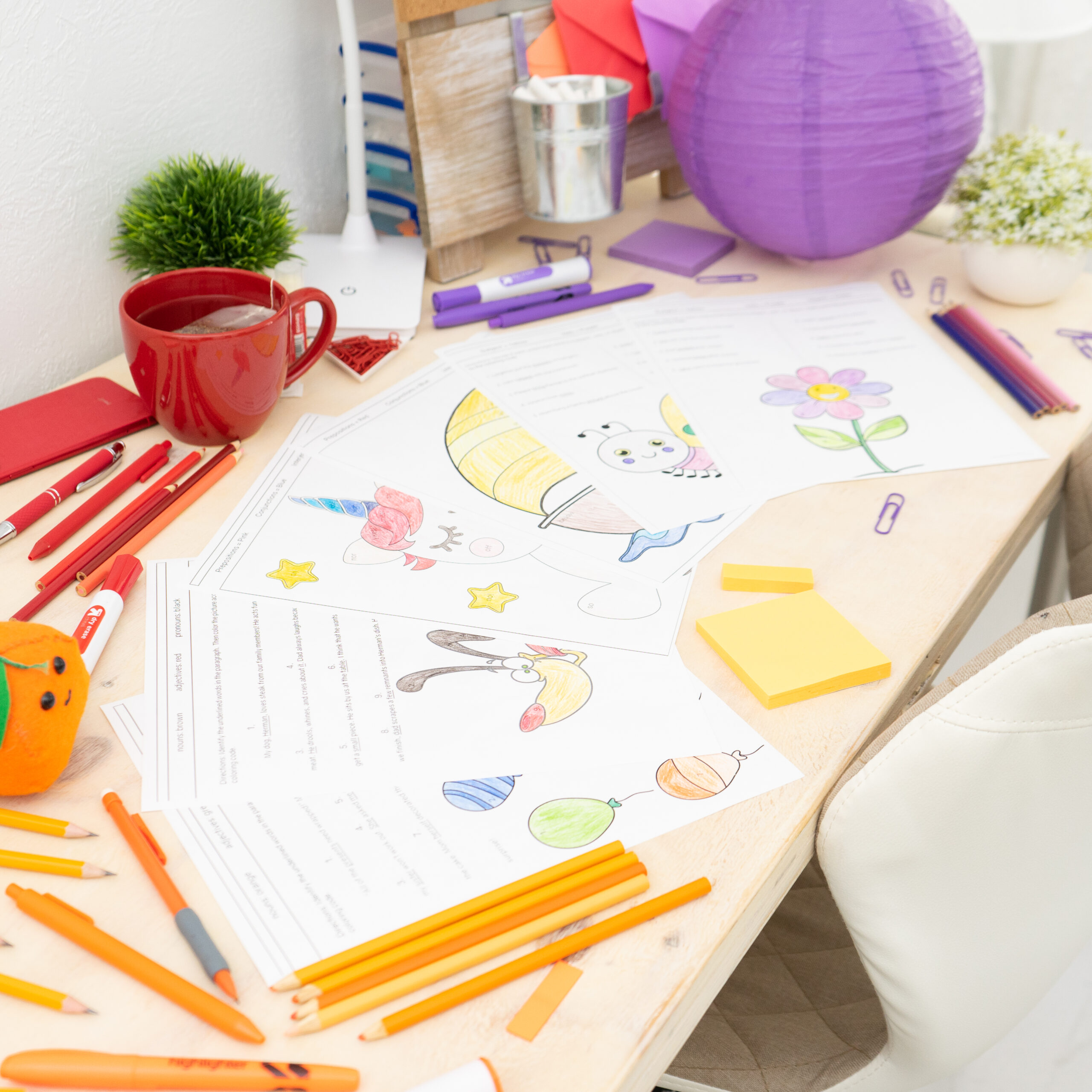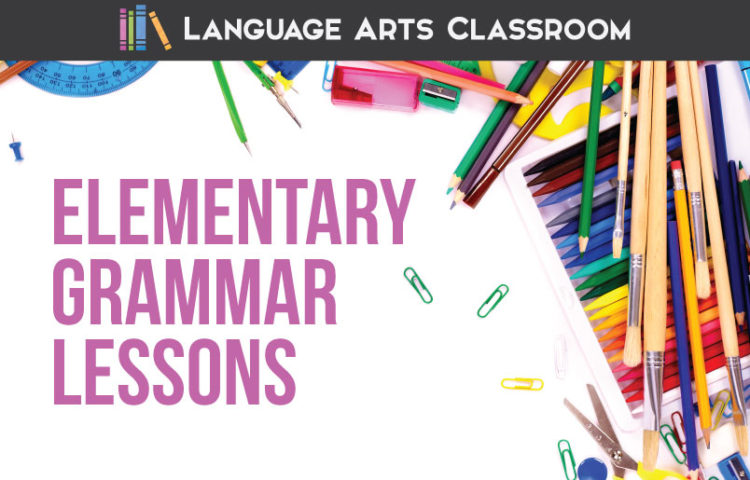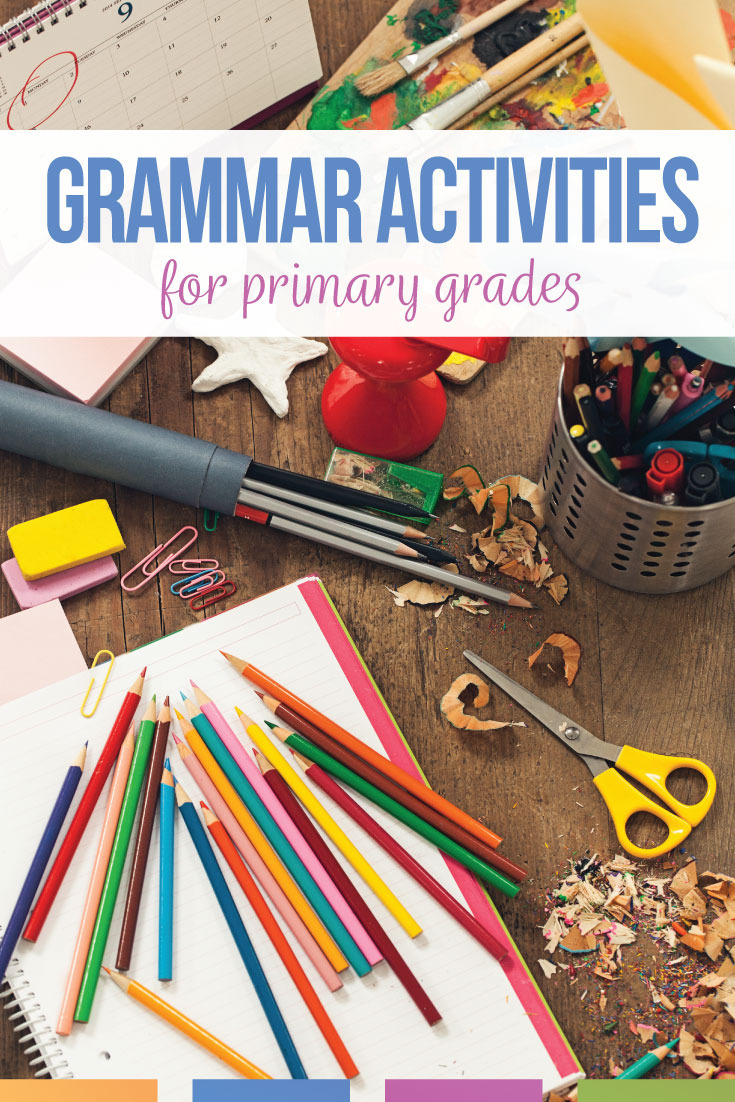My personal children are young, and I often create elementary grammar lessons for them. Making engaging English grammar activities is a passion of mine!
When students have materials that relates to their interests, they are more involved in the lesson. My personal children do grammar lessons at school (I do not teach in their district), but they often need review and extra practice at home. Plus, since I teach grammar with older children, I naturally weave grammatical discussions into their homework and independent reading.
Sometimes I struggle to find activities that resonate with my kids, and because I teach older students who often grumble about grammar, I’m aware that I can make life easier for my own children as well as others. Establishing a strong foundation with language standards prepares students for more difficult reading and writing. My children inspire my primary grammar lessons, and they have NO qualms about giving their mom honest feedback.
What sort of elementary grammar lessons are meaningful?
Meaningful grammar lessons are similar to other meaningful lessons from literature and writing. Plus, I’ve learned that hands-on grammar means more to kiddos than a worksheet. I now apply that knowledge to activities with my older students in the classroom.
What is the goal with younger kids concerning grammar?
I have worked in a school setting with grades 6-12, and I have taught a variety of grammar lessons within those six grades.
When I work with my young (personal) children, I want to:
√ Cultivate an interest in language.
√ Use domain-specific vocabulary in context.
√ Show them that “grammar” is already around them.
Basically, I want to talk about grammatical concepts in low-stress situations. As I read and write with my kids, I show the connection to grammar in fun ways. Plus, I can provide extension activities for them at home.
Here are a few of the elementary grammar lessons I have created with the help of my personal editors.
English grammar connection to literature.
My son obsesses over *Minecraft. He plays the games, builds with the figurines, and wears Minecraft themed clothing. When he started reading the Minecraft books, I knew I wanted to make a few Minecraft lesson plans because I can’t be the only parent or teacher with a child who loves this phenomenon!
Engage younger students with their interests.
I decided to pull parts of speech and create a mentor sentence activity. So, I pulled 48 adjectives and 48 nouns from Ty’s Minecraft: Construction Handbook. I gave the answer sheet’s background a pixelated look and added dotted lines for cutting apart the adjectives and nouns.
Ty is in second grade so he has studied some of the parts of speech. His teachers have done fun activities like making a “noun town” and describing other students with adjectives. He knows the terms.
As we read, we had an interesting discussion about using words as both nouns and adjectives. Some of the nouns are minerals—diamond and gold. Those can also be describing words, words that describe types of tools. I specified that those words would be referencing the minerals, not describing the tools. He glued them in the noun category.
He completed half of the noun and adjective sort, leaving 24 of each for another day.
In the classroom, this would work as a Minecraft station or scoot activity. For us, it worked as a nice extension activity at home. I created the noun and adjective sort, noun and verb sort, and character sentences. Since I would not consider my son a writer, I was thrilled to get his participation with writing.
What are grammar sorts?
Grammar sorts are “sorting” different concepts. I typically put the words, phrases, or clauses on slips of paper. Separating nouns and pronouns (for example) can spur discussions concerning similarities, differences, and uses.
Glue? Yes, my children will eagerly glue and cut! I created a noun and verb sort that had a school theme, thinking that it tied to what Ty knows. He then asked for a nature sort, and I think he enjoyed that one more. With older students, I avoid lots of clipart, but my son enjoyed the bright pictures to help with the words.
Grammar sorts add depth to grammar conversations. Students should understand from a young age that grammar includes the ability to talk about language. When Ty and I work on a sort, we talk about different ways words can be used. I don’t present this fact as a way to confuse him; rather, I present the differences in words as a fun and analytical activity.
My favorite part of sorts is when Ty adds more nouns or verbs to the columns. Grammar sorts can provide room for analytical conversations. Plus, we can sort possessive nouns, plural nouns, and more.
Task cards for nouns, adverbs, conjunctions, and more.
At home, task cards work well because I can complete four or six with my son at a time, and then we can save the rest for another day. I know that at school, I use task cards for review and with stations so students could collaborate and walk. When I taught middle school, I separated task cards into different plastic boxes and used them to differentiate lessons.
We reviewed coordinating and correlative conjunctions. When we read together, we spy the different conjunctions in use. Direct instruction, review, application. I don’t make the discussions a huge deal! We simply notice the concepts in what we read.
Another easy trick I use with task cards is turning the concepts into part of a word wall. Students can take whatever word (from any task card!) and create sentences that then become part of the classroom decor—almost like anchor charts. Another option is to turn the word walls into vocabulary displays, with displays for adverbs, adjectives, and more.
Mentor sentences for capitalization and punctuation.
I stress to my students that grammar is everywhere, in literature, nonfiction, speeches. When I’m with my personal children, I encourage that type of thinking, just as I show them that letters and numbers are in our world. I can easily squeeze elementary grammar topics into discussions with picture books.
At the very least, I can point out the functions in sentences like capitalization, punctuation, capital letters, and more.
From a young age, I ask Ty to see that grammar is part of writing. Sometimes when we write, I’ll ask Ty to “dig” and “dump” a sentence. (He loves construction and trucks and basically all vehicles!) I allow him to choose what sentence he thinks should be better, and we work to improve it with one of our construction-themed writing activities. With those sheets, I ask him to choose a sentence. Then we rearrange and play with the sentences. He loves the vehicles and the metaphor of “building” sentences. Elementary grammar can be easily connected to writing.
Mentor texts and mentor sentences are frequent parts of language arts classes, and those parts can start early.
Coloring verbs, adjectives, pronouns, and more.
We color and write and draw frequently at our house, and coloring with grammar seemed like a natural progression.
Part of working with younger kiddos is familiarizing them with domain-specific vocabulary like “subject” and “object.” As a high school teacher, I see that students who are familiar with basic terms are prepared to work on more difficult concepts like clauses, parallelism, and phrases. Grammar coloring sheets provide elementary grammar lessons with a low-stress activity.
Building connections for learners with vocabulary.
In a few years, elementary grammar lessons will be behind these kiddos. Meeting language standards will look like applying grammatical concepts to writing.
Language lessons will be a little different too. For instance, young writers will change vocabulary words to different forms—change a noun to a verb or adjective, for instance.
My meaning: Those first years of grammar so monumentally important for laying a foundation of understanding language.
English grammar lessons can include more than worksheets! A variety of activities will engage students and provide a foundation for their futures.
As a teacher, I want to problem-solve with my own children. I’ve created elementary grammar lessons based on their interests, and my hope is that they engage your children or students. The more hands-on my elementary school grammar worksheets are, the more my kiddos enjoy them.
* I am in no way affiliated with Minecraft Handbooks or the video game.









